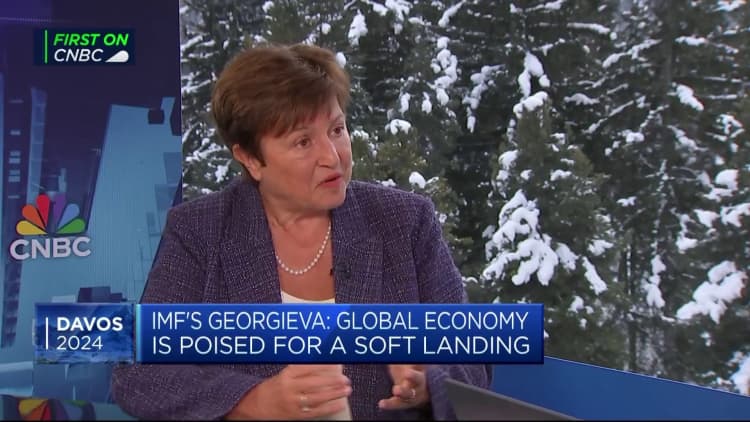IMF upgrades global growth forecast, citing U.S. resilience and policy support in China


Buildings in Pudong’s Lujiazui Financial District in Shanghai, China, on Monday, Jan. 29, 2024.
Bloomberg | Bloomberg | Getty Images
The International Monetary Fund on Tuesday nudged its global growth forecast higher, citing the unexpected strength of the U.S. economy and fiscal support measures in China.
It now sees global growth in 2024 at 3.1%, up 0.2 percentage point from its prior October projection, followed by 3.2% expansion in 2025.
Large emerging market economies including Brazil, India and Russia have also performed better than previously thought.
The IMF believes there is now a reduced likelihood of a so-called hard landing, an economic contraction following a period of strong growth, despite new risks from commodity price spikes and supply chain issues due to geopolitical volatility in the Middle East.
It forecasts growth this year of 2.1% in the U.S., 0.9% in both the euro zone and Japan, and 0.6% in the United Kingdom.
“What we’ve seen is a very resilient global economy in the second half of last year, and that’s going to carry over into 2024,” the IMF’s chief economist, Pierre-Olivier Gourinchas, told CNBC’s Karen Tso on Tuesday.
“This is a combination of strong demand in some of these countries, private consumption, government spending. But also, and this is quite important in the current context, a supply component as well. … So very strong labor markets, supply chain frictions that have been easing, and the decline in energy and commodity prices.”
The latest official figures showed the U.S. economy tearing past economists’ expectations in the fourth quarter, with growth of 3.3%.
China has faced a host of issues over the last year, including a disappointing rebound in post-pandemic spending, concerns over deflation and an ongoing property sector crisis. The government has rolled out a host of stimulus measures in response, contributing to the IMF’s upgrade.
However, the IMF’s forecasts remain below the global growth average between 2000 and 2019 of 3.8%. Higher interest rates, the withdrawal of some fiscal support programs and low productivity growth continue to weigh, the institution said.

But restrictive monetary policy has led to inflation falling faster than expected in most regions, which Gourinchas called the “other piece of good news” in Tuesday’s report. The IMF sees global inflation at 5.8% in 2024 and 4.4% in 2025. In advanced economies, that falls to 2.6% this year and 2% next year.
“The battle against inflation is being won, and we have a higher likelihood of a soft landing. So that sets the stage for central banks, the Federal Reserve, the European Central Bank, the Bank of England, and others, to start easing their policy rates, once we know for sure that we are on that path,” Gourinchas said.
“The projection right now is that central banks are going to be waiting to get a little bit more data, they are going meeting by meeting, they are data dependent, confirming that we are on that path. That’s the baseline. And then if we are, then by the second half of the year we’ll see rate cuts,” he said.
While central banks must not ease too early, there is also a risk coming into sight of policy remaining too tight for too long which would slow growth and bring inflation below 2% in advanced economies, Gourinchas added.









